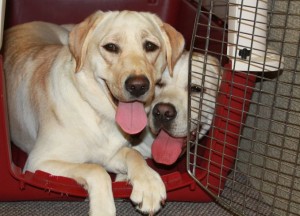Many old time bird dog trainers advocated teaching the first command to be ” Kennel” for young bird dogs. The crate is first used to teach the command kennel and later the command kennel can be used with a point to the pick up, outdoor kennel, a crate, porch or most anywhere and your quail hunting machine will go where you want them to go without question.
CRATE TRAINING
by Geoffrey English
Often clients ask, “What do you think about crate training?” My standard answer, “Crate training is the most misunderstood training technique a new dog owner faces today. Like most things in life, people often criticize what they don’t understand. Personally, I crate train all my dogs that live in the house. Many people have a misconception about what crate training is or what it is not.” In this month’s article I will attempt to dispel some of the myths about crate training and give you some simple techniques that you can begin using today to make the process of crate training easy and create a “domestic den” for your dog.
a new dog owner faces today. Like most things in life, people often criticize what they don’t understand. Personally, I crate train all my dogs that live in the house. Many people have a misconception about what crate training is or what it is not.” In this month’s article I will attempt to dispel some of the myths about crate training and give you some simple techniques that you can begin using today to make the process of crate training easy and create a “domestic den” for your dog.
When done properly, crate training offers dog owners two valuable benefits. First, the crate becomes the place your dog can call home. Second, crate training can considerably speed up the housebreak process.
A Place Your Dog Can Call Home
If you step back in time and look at the canine before man’s domestication – the wolf, you would find a “denning animal” that naturally made himself or herself a home in small burrows on the side of hills and underneath blow downs. These burrows or “dens” were constructed to escape from predators. The early canine quickly realized that a small den just large enough to turn around in would offer shelter from the elements and allow them to efficiently conserve on body heat during the winter months.
Have you ever noticed where your dog goes to escape the hustle and bustle of family life? Inevitably, you will find him or her out of the traffic area and lying under a table or a chair. These areas offer you’re dog the solitude he so desperately seeks. Dogs feel more secure in “denning” environments. If he wishes to get away from the kids or the active of your family you will find that he will retreat to his crate / domestic den. Employing the use of a crate in your home will provide your dog with a place he can call home.
A Home Away From Home
Whether you’re on the road in competition or on vacation, the crate provides a convenient portable den that offers dogs and owners a safe and stress-free way to travel. I have found dogs that are crate trained will experience much less stress on overnight trips than dogs that are not crate trained. This can often be the factor that makes for a successful day in the field.
Crate Training and Housebreaking
Dealing with a crying puppy is often the first problem a new puppy owner must face when crate training. Start by placing your puppy in his new crate for very short intervals. Sometimes beginning with sessions measured in seconds rather than minutes or hours is the best approach. Even better yet, try feeding your puppy in a crate. This will help your young dog establish a positive association towards the crate.
Try placing an garment or blanket with the mother’s scent on it in the crate with the puppy. Additionally, placing a ticking alarm clock outside the kennel can be comforting to your new puppy for the first few nights away from his littermates.
During the first night a puppy is separated from the rest of the litter he will often whine and fuss. This behavior is a very natural survival skill learned early in life. Whether in the whelping box or in the wild, a puppy learns very quickly that when separated from the pack, calls for help will allow other members of the pack to quickly located him, thus reuniting him with his peers. To that extent, many animal behaviorists recommend allowing a new puppy to sleep in the same room with you to reduce this separation anxiety.
Moving a crate into your bedroom accomplishes two things. First, as stated above, it reduces separation anxiety for the puppy. Second, it allows you to monitor your puppy’s housebreaking routine. Before putting your puppy up for the night, make sure he has had a chance to go outside and eliminate.
Inevitably, you will find that as you close the door to the crate he will begin to whine and fuss. Never let your dog out of the crate if he is crying. At first this may not sound logical. But remember, dogs learn quickly through associations. If you open the door when he cries he will quickly think crying opens the door. At this point you will want to introduce a “NO NOISE” command and bang your hand on the top of the crate. If the puppy continues to whine, just ignore him. The last thing you want to do is reward this behavior by opening the crate door and comforting him. The only exception to this rule is when crying is a result of having to go to the bathroom. Therefore you will need to go on those “midnight-walks”. Then if at all possible, wait for a break in the crying before opening the door, even if it is a break for only10 seconds.
The crate can be an effective tool when housebreak your new companion. The underlying reason for this is fairly simple. Dogs normally will not eliminate in the same areas they live. It’s only when a dog has been left in a crate too long that they are forced to eliminate in the crate. Remember, young dogs are not physically able to “hold-it” for hours and hours on end. So when deciding to put your youngster up for the evening, be mindful of how long he or she will be able to comfortably “hold-it”. During the night, if your puppy seems to be stirring, get up and take him outside immediately. With puppies you may have to carry them outside to avoid accidents. Once he has had a chance to relieve himself, bring him straight back inside to his crate. If he begins to fuss again, issue the “NO NOISE” command and be consistent.
After a few nights of dealing with the whining and carrying on, your puppy should begin to make it through the night with minimal fussing. Crate training takes time and sometimes requires a “deaf ear” on your part. Use common sense and consistency in your approach and soon the answer, as whether to crate or not to crate will become obvious. Good luck and enjoy your new puppy.
Rules to live by when crate training
1. The crate should never be used to punish your dog.
2. Keep the introduction to the crate short and sweet. Let the dog get comfortable with the crate before attempting to close the door on him. Once you close the door, reward him with praise and/or a treat. Keep the first few sessions with the door shut short. Ten seconds without crying is what you’re striving for. Open the door and give him lots of love and praise. Slowly, and I mean slowly, increase the time with the door shut.
3. Select the proper size crate for your dog. If you buy a crate that is large enough to accommodate him when he is full-sized, block off an area inside the crate to make it just large enough for him to stand up and turn around. Making it too large will allow him to soil one area and live in the other.
4. Pick up your dog’s water 3-4 hours before putting him up for the night.
5. Allow your dog to eliminate completely prior to being put up for the night.
6. Take him outside immediately upon letting him out of the crate. With puppies, you may have to carry them outside to avoid accidents.
7. Let him naturally find the crate in your kitchen, living room or wherever you decide the crate will reside. Make sure you place the crate in an area well circulated, free of drafts, and out of direct sunlight. Placing food in the back of the crate will encourage your pet to explore and enter this new area.
8. Never let your dog out of the crate if he is crying.
9. Have a vigorous play session before to going to bed.
10. An undergarment or a ticking alarm clock can comfort a new puppy during his first few nights away from his littermates.
11. Never disturb your dog when he seeks solitude in his crate. Remember this is his domestic den and like you, he needs valuable time alone.
12. Finally, be patient and committed to the process.
